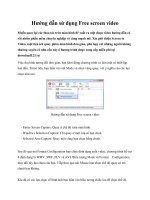Cartoon Person Skeleton Setup Video pdf
Bạn đang xem bản rút gọn của tài liệu. Xem và tải ngay bản đầy đủ của tài liệu tại đây (26.53 KB, 5 trang )
Cartoon Person Skeleton Setup Video
It's a good idea to create your cartoon person with a skeleton
underlying his or her skin. There are a couple of reasons why you may
want to do this. A skeleton gives you a great starting point that you can
use to pose your character in many different positions, and it also gives
you a familiar framework that you can always go back to, no matter
what kind of character you are drawing.
Without wasting any more time, let's get right into creating a skeleton
that you can begin using to create and pose a cartoon person of your
own.
Basic proportions for a fully grown human are approximately 8 heads
tall. Because this is a cartoon character we're not going to get hung up
on standard proportions, but if you want to learn more about drawing
realistic people you can check out the Figure Drawing Lessons.
To keep things simple we'll draw this cartoon person from the front
view. Start off by drawing a circle for the head. We want to keep the
skeleton simple so that once we become familiar with it's structure we
can draw it in many different positions quickly and easily.
Add a short line for the neck. Remember here that we're drawing a
simple skeleton. Become familiar with this initial setup before you start
to experiment too much with squashing and stretching it to fit all sorts
of different characters.
Next up is the ribcage. The ribs should flair slightly as they extend
downward from the neck. If you look at and think about the way your
own ribs are structured you should notice that they are rounded.
Though you won't be able to see the roundness from the front view, it's
important to keep the form of the ribs in mind when you begin to pose
your cartoon person later. At the top of the ribs you can draw two small
circles to indicate the shoulders. This is a very simplified version of the
skeleton but it should give you more than enough information to help
design and pose any kind of cartoon person you can imagine.
Draw another line down from the middle of the ribs for where the spine
connects to the hips. The hip bone is trapezoid. If you look at the side
view of this skeleton you can see the full width of the simplified hips.
Add two small balls to each side of the hips were the thigh bone
connects to the pelvis.
How to Draw the Arms and Legs:
The arms should start at the shoulder ball and extend down almost to
the bottom of the ribs where the elbow is. Draw another ball for the
elbow. From the elbow draw the forearm downward to just around the
bottom of the hips. This is where the wrist is, and for the hand we'll just
add a block shape for now.
I personally find that it's easier to worry about the fingers when you are
making your final drawing rather than at the beginning when you are
just starting to design and pose your character. These lengths of the
upper and lower arms should be kept in mind at all times when you are
posing your character. You're free to lengthen or shorten the arms as
you wish, but when you start to ignore standard human proportions too
much you may get into dangerous territory where you're characters
begin to look too unbelievable.
And now for the Legs: Just like the arms, we'll draw lines extending
down for the upper and lower leg that are joined at the knee with
another ball. At the bottom of the lower leg draw a block for the foot.
That'll give us a decent skeleton for our cartoon person.
Watch the video below to see how this all comes together
Ok Great, I have a Skeleton of a Cartoon Person, now what?
There are three things that you can do once you have your skeleton.
You could try to draw the skin and muscle on top of him to look like a
finished character, you could try to pose him, or you could create some
more skeletons to get familiar with the setup and experiment with
different shapes and sizes for the body parts.
I suggest that you keep practicing the skeleton construction until you
are very familiar with it to the point that you won't forget it. Really
learn it by having fun and playing with it. See what you can make your
skeleton do and what kinds of interesting positions you can put him
into.









